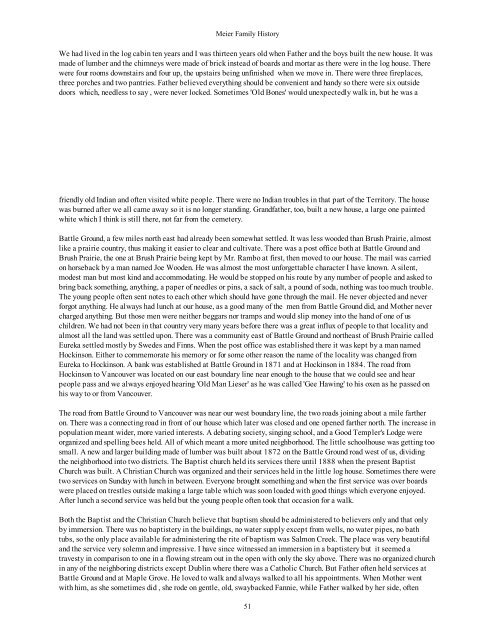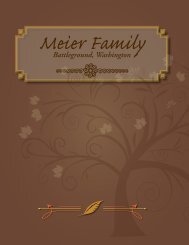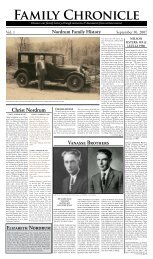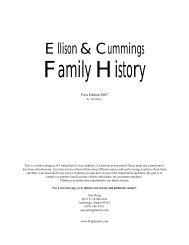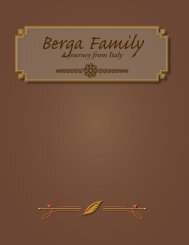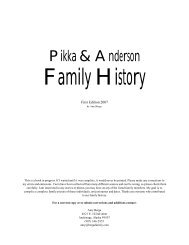Meier & Matson Family History
Meier & Matson Family History
Meier & Matson Family History
You also want an ePaper? Increase the reach of your titles
YUMPU automatically turns print PDFs into web optimized ePapers that Google loves.
<strong>Meier</strong> <strong>Family</strong> <strong>History</strong><br />
We had lived in the log cabin ten years and I was thirteen years old when Father and the boys built the new house. It was<br />
made of lumber and the chimneys were made of brick instead of boards and mortar as there were in the log house. There<br />
were four rooms downstairs and four up, the upstairs being unfinished when we move in. There were three fireplaces,<br />
three porches and two pantries. Father believed everything should be convenient and handy so there were six outside<br />
doors which, needless to say , were never locked. Sometimes 'Old Bones' would unexpectedly walk in, but he was a<br />
friendly old Indian and often visited white people. There were no Indian troubles in that part of the Territory. The house<br />
was burned after we all came away so it is no longer standing. Grandfather, too, built a new house, a large one painted<br />
white which I think is still there, not far from the cemetery.<br />
Battle Ground, a few miles north east had already been somewhat settled. It was less wooded than Brush Prairie, almost<br />
like a prairie country, thus making it easier to clear and cultivate. There was a post office both at Battle Ground and<br />
Brush Prairie, the one at Brush Prairie being kept by Mr. Rambo at first, then moved to our house. The mail was carried<br />
on horseback by a man named Joe Wooden. He was almost the most unforgettable character I have known. A silent,<br />
modest man but most kind and accommodating. He would be stopped on his route by any number of people and asked to<br />
bring back something, anything, a paper of needles or pins, a sack of salt, a pound of soda, nothing was too much trouble.<br />
The young people often sent notes to each other which should have gone through the mail. He never objected and never<br />
forgot anything. He always had lunch at our house, as a good many of the men from Battle Ground did, and Mother never<br />
charged anything. But those men were neither beggars nor tramps and would slip money into the hand of one of us<br />
children. We had not been in that country very many years before there was a great influx of people to that locality and<br />
almost all the land was settled upon. There was a community east of Battle Ground and northeast of Brush Prairie called<br />
Eureka settled mostly by Swedes and Finns. When the post office was established there it was kept by a man named<br />
Hockinson. Either to commemorate his memory or for some other reason the name of the locality was changed from<br />
Eureka to Hockinson. A bank was established at Battle Ground in 1871 and at Hockinson in 1884. The road from<br />
Hockinson to Vancouver was located on our east boundary line near enough to the house that we could see and hear<br />
people pass and we always enjoyed hearing 'Old Man Lieser' as he was called 'Gee Hawing' to his oxen as he passed on<br />
his way to or from Vancouver.<br />
The road from Battle Ground to Vancouver was near our west boundary line, the two roads joining about a mile farther<br />
on. There was a connecting road in front of our house which later was closed and one opened farther north. The increase in<br />
population meant wider, more varied interests. A debating society, singing school, and a Good Templer's Lodge were<br />
organized and spelling bees held. All of which meant a more united neighborhood. The little schoolhouse was getting too<br />
small. A new and larger building made of lumber was built about 1872 on the Battle Ground road west of us, dividing<br />
the neighborhood into two districts. The Baptist church held its services there until 1888 when the present Baptist<br />
Church was built. A Christian Church was organized and their services held in the little log house. Sometimes there were<br />
two services on Sunday with lunch in between. Everyone brought something and when the first service was over boards<br />
were placed on trestles outside making a large table which was soon loaded with good things which everyone enjoyed.<br />
After lunch a second service was held but the young people often took that occasion for a walk.<br />
Both the Baptist and the Christian Church believe that baptism should be administered to believers only and that only<br />
by immersion. There was no baptistery in the buildings, no water supply except from wells, no water pipes, no bath<br />
tubs, so the only place available for administering the rite of baptism was Salmon Creek. The place was very beautiful<br />
and the service very solemn and impressive. I have since witnessed an immersion in a baptistery but it seemed a<br />
travesty in comparison to one in a flowing stream out in the open with only the sky above. There was no organized church<br />
in any of the neighboring districts except Dublin where there was a Catholic Church. But Father often held services at<br />
Battle Ground and at Maple Grove. He loved to walk and always walked to all his appointments. When Mother went<br />
with him, as she sometimes did , she rode on gentle, old, swaybacked Fannie, while Father walked by her side, often<br />
51


